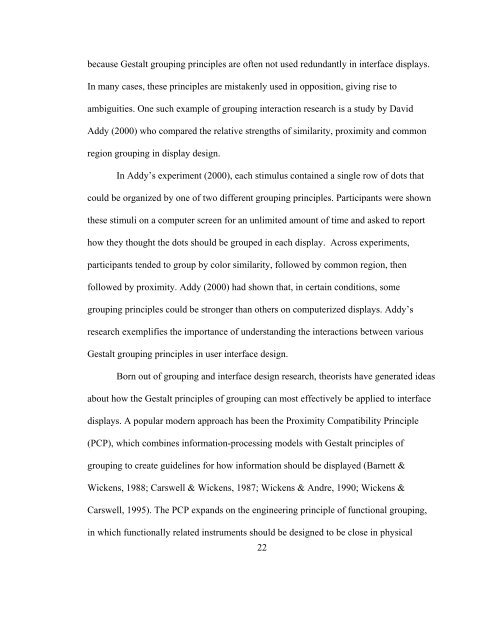The Use of Iambic Pentameter in the
The Use of Iambic Pentameter in the
The Use of Iambic Pentameter in the
Create successful ePaper yourself
Turn your PDF publications into a flip-book with our unique Google optimized e-Paper software.
ecause Gestalt group<strong>in</strong>g pr<strong>in</strong>ciples are <strong>of</strong>ten not used redundantly <strong>in</strong> <strong>in</strong>terface displays.<br />
In many cases, <strong>the</strong>se pr<strong>in</strong>ciples are mistakenly used <strong>in</strong> opposition, giv<strong>in</strong>g rise to<br />
ambiguities. One such example <strong>of</strong> group<strong>in</strong>g <strong>in</strong>teraction research is a study by David<br />
Addy (2000) who compared <strong>the</strong> relative strengths <strong>of</strong> similarity, proximity and common<br />
region group<strong>in</strong>g <strong>in</strong> display design.<br />
In Addy’s experiment (2000), each stimulus conta<strong>in</strong>ed a s<strong>in</strong>gle row <strong>of</strong> dots that<br />
could be organized by one <strong>of</strong> two different group<strong>in</strong>g pr<strong>in</strong>ciples. Participants were shown<br />
<strong>the</strong>se stimuli on a computer screen for an unlimited amount <strong>of</strong> time and asked to report<br />
how <strong>the</strong>y thought <strong>the</strong> dots should be grouped <strong>in</strong> each display. Across experiments,<br />
participants tended to group by color similarity, followed by common region, <strong>the</strong>n<br />
followed by proximity. Addy (2000) had shown that, <strong>in</strong> certa<strong>in</strong> conditions, some<br />
group<strong>in</strong>g pr<strong>in</strong>ciples could be stronger than o<strong>the</strong>rs on computerized displays. Addy’s<br />
research exemplifies <strong>the</strong> importance <strong>of</strong> understand<strong>in</strong>g <strong>the</strong> <strong>in</strong>teractions between various<br />
Gestalt group<strong>in</strong>g pr<strong>in</strong>ciples <strong>in</strong> user <strong>in</strong>terface design.<br />
Born out <strong>of</strong> group<strong>in</strong>g and <strong>in</strong>terface design research, <strong>the</strong>orists have generated ideas<br />
about how <strong>the</strong> Gestalt pr<strong>in</strong>ciples <strong>of</strong> group<strong>in</strong>g can most effectively be applied to <strong>in</strong>terface<br />
displays. A popular modern approach has been <strong>the</strong> Proximity Compatibility Pr<strong>in</strong>ciple<br />
(PCP), which comb<strong>in</strong>es <strong>in</strong>formation-process<strong>in</strong>g models with Gestalt pr<strong>in</strong>ciples <strong>of</strong><br />
group<strong>in</strong>g to create guidel<strong>in</strong>es for how <strong>in</strong>formation should be displayed (Barnett &<br />
Wickens, 1988; Carswell & Wickens, 1987; Wickens & Andre, 1990; Wickens &<br />
Carswell, 1995). <strong>The</strong> PCP expands on <strong>the</strong> eng<strong>in</strong>eer<strong>in</strong>g pr<strong>in</strong>ciple <strong>of</strong> functional group<strong>in</strong>g,<br />
<strong>in</strong> which functionally related <strong>in</strong>struments should be designed to be close <strong>in</strong> physical<br />
22

















